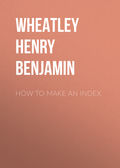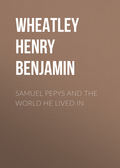
Wheatley Henry Benjamin
Prices of Books
BOOKS ON VELLUM
Collectors have always had a fancy for these very choice books, and that the taste has not yet died out is seen from the fact that the late William Morris printed copies of the beautiful books issued from the Kelmscott Press on vellum, and was particularly careful in the selection of the skins, which he obtained at first from Italy. A complete set of all the books on vellum (including Chaucer), forty-nine volumes, were offered at the Kelmscott Press for £650, and have been sold at that price.
We can understand the early printed books being struck off upon vellum, as the printers appreciated that material on account of its use by the scribes in the production of the beautiful manuscripts of a former age, but it is surely infinitely more convenient to have a book printed on good paper rather than on such a refractory material as vellum. Some collectors have been so infatuated as to confine their libraries to books printed on vellum, and the French Marshal Junot was one of them. Modern books were printed for him on this substance; but when they came to be sold it was found that the public did not care much for his books, and more than half of them were bought in. One of the lots illustrates in a remarkable manner the advance in prices at the present time. The book was Longus’s Pastoralia, printed by Didot in 1802. One copy only was pulled on vellum for the Marshal, and this volume contained the original drawings of Proudhon, and a set of proof impressions of the engravings. At the Junot sale in 1816 this book only realised £37, 10s.; at the Beckford sale it brought £900. One of the most charming of Junot’s books was the Didot Horace of 1799 folio, a volume which contained the original drawings from which the copperplate vignettes were executed. This was bought by George Hibbert for £140.
Of old books, mention may be made of the dedication copy to James V. of John Bellenden’s translation of Hector Boece’s “Cronikles of Scotland” (1536), which was printed on vellum, and which, in a fine old binding, realised at the Duke of Hamilton’s sale (1884), £800.
Dibdin styled this hobby of collectors the fifth symptom of the bibliomania, and he gave a list of the vellum-printed books in Count MacCarthy’s and James Edwards’s libraries. In the latter collection was a copy of Martin Luther’s German Bible (Augsburg, 1535, two vols. folio), which sold for the reasonable price of £52, 10s. These copies on vellum were printed at the charge of John Frederick, Elector of Saxony.
Edwards employed Bodoni to print for him six copies of the edition of the “Castle of Otranto” (Parma, 1791) on vellum, and his own copy, made up with a selection of the best sheets, sold at his sale in 1815 for £29, 8s.
At Watson Taylor’s sale Pope’s “Essay on Man” (1819), printed on vellum, sold for £10.
Mention has already been made of the grand copies on vellum of the earliest productions of the printing-press—the Mazarin Bible, &c.
ILLUSTRATED BOOKS
Good illustrated books, which are an ornament to any library, are now high priced, and are not likely to fall in value. Such books as Dibdin’s bibliographical works, Rogers’s “Italy” and “Poems,” and many other books of a like kind, must always be a delight to the æsthetic collector.
Collections of engraved portraits have realised great prices, such as Holland’s Basiliωgia (1618), which sold for £600 at Christie’s in 1811; and his Herωologia (1620), which sold for £17 at the Beckford sale, £28, 10s. at the Earl of Crawford’s sale (1887), and £19, 15s. at W. H. Crawford’s (Lakelands) sale (1891); and the superb series of Vandyck’s etchings, which sold for £2850 at the Beckford sale.
Great prices have also been paid for extra illustrated books; but it is useless to record the prices given for them, unless a list of the contents is given also. Grangerising has been ridiculed with much justice, and some of the bulky works which have been produced, such as the illustrated Bibles and Shakespeares, are instances of a very absurd mania. Dr. Hill Burton gave an amusing and by no means exaggerated sketch in his “Book Hunter” of how the compiler set about his work. Now in England Grangerising is mostly confined within the limits of illustrating topographical works with views and historical books with portraits, but in the United States the old plan is said to be still in force.
BINDINGS
In no class of books have prices more conspicuously advanced than in the case of bindings, and in many sales that have taken place of late years fine specimens have been brought to the hammer; but no sale could compare with that of the Beckford library in this respect. Good examples of the libraries of Margaret of Valois, Maioli, Grolier, Thuanus, and Canevari are eagerly sought after, and the following prices of some of the choicest of these bindings will give readers an idea of the current values of these charming books:—
Marguerite de Valois. Carmina illustrium Poetarum Italorum, 1579, 2 vols. Old brown morocco, covered with the arms and devices of Marguerite de Valois.
Beckford (1882), £242.
Diane de Poictiers. Le Livre des Statuts et Ordonances de l’Ordre de Sainct Michel (Paris, 1550), printed on vellum. A beautiful specimen of the library of Diane de Poictiers, in old brown morocco, ornamented with the arms of Henry II. of France, the crescent, bows and quivers of Diana, and fleurs de lis.
Beckford (1882), £155.
Grolier. I. Aurelius Augurellus (Venetiis: Aldus, 1505). Brown morocco, beautiful specimen of Grolier’s library.
Beckford (1882), £250.
–– Lucanus cura Aldi Romani (Venetiis: Aldus, 1515). Grolier’s copy, covered with scroll tooling.
Beckford (1882), £290.
–– Another copy, veau fauve, with Grolier tooling, £120.
Grolier and Thuanus. Lucanus de Bello Civili (Lutetiæ: R. Stephanus, 1545). Brown morocco, covered with Grolier tooling; apparently bound for Grolier, and subsequently possessed by Thuanus.
Beckford (1882), £135.
–– Franchini Poemata (Romæ, 1554). Red morocco, covered with Grolier tooling, and monogram of the Marquis de Menars on back, from the libraries of Grolier and Thuanus.
Beckford (1882), £230.
Grolier and Thuanus. Buchanani Psalmorum Paraphrasis Poetica (apud H. et R. Stephanum, s.a.). Olive morocco, sides and back covered with gold tooling in the Grolier style, the first arms of Thuanus forming the centre ornament.
Beckford (1882), £310.
Louis XIII. and Anne of Austria. Sainct Johan Zebedee L’Apocalypse, Mystère (Paris, 1541). Blue morocco, richly ornamented with gold tooling and the crowned cyphers of Louis XIII. and Anne of Austria, by A. Ruette.
Beckford (1882), £255.
Demetrio Canevari, Physician to Urban VIII. Tirante il Bianco (Vinegia, 1538). A perfect specimen of Canevari’s library, in Venetian red morocco, with his device.
Beckford (1883), £111.
Du Fresnoy. Lucanus de Bello Civili (Lugd. Bat., 1658). Red morocco, richly ornamented with gold tooling, with arms and monogram of H. Petit Du Fresnoy stamped on the sides and back, by Boyet.
Beckford (1882), £84.
Marguerite de Montmorency, Dame de Fosseteau. Duchesne, Histoire genealogique de la maison de Montmorency et de Laval, 2 vols. in 1 (Paris, 1624). Old olive morocco, the sides and back covered with the MF and device (the Marguerite) of Marguerite de Montmorency.
Beckford (1882), £120.
A few instances of the work of the great French binders follow, and it will be seen that the work of no binder is more appreciated by collectors than that of Monnier:—
Clovis Eve. Coloured Drawings of Maps and Plans of places in France, executed in 1602 and 1603 for Henry IV.’s own use. Olive morocco, covered with fleurs de lis, the King’s arms forming the centre ornament, with his crowned H at each corner. A magnificent specimen of Clovis Eve’s art.
Beckford (1882), £375.
Boyet. In the second portion of the Sunderland library there was a small volume in old crimson morocco (Cicero, De Officiis, Amst. ex off. Elzeviriani, 1677), which was not specially described, nor the title printed in capitals. It did not look worth many pounds, but Mr. Quaritch obtained it after an exciting contest with Mr. Morgand for £120. The cause of the excitement was this: from the character of the end papers it was judged that the book had been bound by the French binder Boyet. Specimens of his handiwork are very rare, and hence the great price.
Deseuil (or Du Seuil). In the second portion of the Beckford library was a copy of the Leyden edition of Macrobius (1670), bound in red morocco doublé by Deseuil. This fetched £39, while another copy in vellum only realised 16s.
Here is another instance of the increased value of a copy of a book bound by a good binder. A copy of Montaigne, Essais, 3 vols. 8vo (Amst.: Elzevir, 1659), bound in red morocco double by Deseuil, brought £200, while another copy, bound by Roger Payne in red morocco, only sold for £12, 10s.
A small duodecimo volume bound by Deseuil (Longus, Les Amours Pastorales de Daphnis et Chloe, Paris, 1788) was sold at G. Daniel’s sale in 1864 for £92.
Monnier. Decor Puellarum (Venetia: N. Jenson, 1471). Girardot de Prefond’s copy, a magnificent specimen of Monnier’s binding, in blue morocco, ornamented with flowers worked on variegated leathers, and stamped in gold.
Beckford (1883), £530.
–– De l’Imitation de Jesus Christ traduction nouvelle (Paris, 1690). Large paper. Citron morocco, magnificent specimen of Monnier’s binding.
Beckford (1882), £356.
–– Corneille, Rodogune. Au Nord [Versailles], 1760. Madame de Pompadour’s own copy, printed under her eyes in a northern apartment of the Palace of Versailles, in yellow morocco; fine specimen of Monnier’s binding.
Beckford (1882), £325.
It has hitherto been the fine French and Italian bindings that have fetched the high prices, but now some of the beautiful English bindings of the seventeenth and eighteenth centuries are coming in for their share of consideration. At the Earl of Orford’s sale (1895) R. Wood’s “Essay on Homer” (1785), bound by Roger Payne by order of Wood’s widow for presentation to Horace Walpole, sold for ten guineas. There is an interest in this book as having fallen into the hands of Goethe when his powers were first developing themselves, and it strongly interested him. Robert Wood was Under-Secretary of State in 1762, and he related an affecting anecdote of Lord Granville, a statesman known now only to the few. Wood was directed to wait upon the President of the Council (Lord Granville) a few days before he died with the preliminary articles of the Treaty of Paris. “I found him,” he continued, “so languid that I proposed postponing my business for another time; but he insisted that I should stay, saying that it could not prolong his life to neglect his duty,” adding a quotation from Homer, which may be found in Mr. Matthew Arnold’s discourses on Homeric translations.
EARLY EDITIONS OF MODERN AUTHORS
The last five-and-twenty years has seen the rise of a new taste in early editions of the works of modern authors, and a new class of bibliographers has arisen to describe these books.
Mr. J. H. Slater (the editor of “Book Prices Current”) has published a useful guide to this subject, entitled “Early Editions: a Bibliographical Survey of the Works of some popular Modern Authors. London, 1894.”
I have taken some particulars from this book, and supplemented them with a note of the prices realised at the remarkable sale of Mr. Alfred Crampton’s collection in 1896. I have also added a few books sold since that date.
Among the first of modern books to sell for high prices were the illustrated novels of Dickens and Thackeray, and to be valuable these must be in perfect condition, with the original wrappers, &c. After these come the other books illustrated by Cruikshank, “Phiz,” Leech, and others, viz., Ainsworth’s and Lever’s novels, Surtees’ Sporting novels—“Sponge’s Sporting Tour,” “Jorrocks’s Jaunts,” “Handley Cross,” &c.
Of poets, Shelley’s pieces were among the first to attain high prices, and Byron’s among the last.
Arnold.—Matthew Arnold’s “Strayed Reveller. By A.,” 1849, and “Empedocles on Etna,” 1852, have long been classed among the rare books. The former was published at 4s. 6d., and its usual price now is £4, but a copy has fetched £7. The latter was published at 6s., and is now valued at from £3, 10s. to £6.
Beckford, Poetical Sketches.
Gaisford (1890), £40.
Blake (W.), Songs of Innocence and of Experience [1789]. Engraved and coloured by Blake, in green morocco by Lewis.
Sir W. Tite, £61. Lord Beaconsfield, £85. Beckford (1882), £146.
–– Milton: a Poem. Engraved throughout, and ornamented with designs by Blake, blue morocco by Mackenzie.
Beckford (1882), £230.
Browning.—Robert Browning’s first publication, which appeared when its author was in his twenty-first year, is a great rarity.
“Pauline; a Fragment of a Confession. ‘Plus ne suis ce que j’ai été, Et ne le sçaurois jamais être.’—Marot. London: Saunders & Otley, Conduit Street, 1833.”
Mr. Slater says that there are about eight copies known, and that it was supposed to be worth £40 or £50. A copy, with an autograph note by the author, was sold at Alfred Crampton’s sale for £145. Mr. Thomas J. Wise printed a facsimile reprint in 1886, which has been used by the forger to deceive. Mr. Slater had seen a “doctored” copy of this reprint, in which Wise’s title and prefatory note were removed, the paper was rotted to make it porous, and the leaves were smoked to give them a mellow appearance. Mr. Wise’s paper is thicker than the original, and Mr. Slater gives a hint how to distinguish the two:—
“On the final page (71) appear the words—‘Richmond, October 22, 1832.’ If the word ‘October’ is printed in thin italics the book is without doubt a reprint. So far as I am aware, there is no other difference between Mr. Wise’s excellent reprint and the original (the paper excepted).”
Burns.—The most amazing price ever realised for a modern book was that of £572 for “Poems chiefly in the Scottish dialect. By Robert Burns. Kilmarnock, 1786.” The original price of this octavo volume was three shillings. The history of the very fine copy sold in Edinburgh in February 1898 is traced back about eighty years by a writer in Literature. In 1870 it was sold for six guineas to G. B. Simpson, of Dundee, who sold it in 1879, with some other books, to A. C. Lamb for £124. The price of the Kilmarnock Burns has steadily advanced from £3, 10s. in 1858 to £111 in 1888, and then it made the immense leap to £572.
Byron.—“Poems on Various Occasions” (Newark, 1807, 8vo) sold at Alfred Crampton’s sale for £45. “The Waltz” (1813, pp. 27), published without a wrapper at 3s., sold at the same sale for £55. Mr. Slater says that an uncut copy has been sold by auction for £86.
Meredith.—A fine uncut copy of George Meredith’s Poems, 1851, sold at a sale of Rare Books and Manuscripts (Sotheby, March 1897) for £17, 10s. Another copy with alterations in the author’s autograph (Sotheby, June 1897) sold for £25.
Morris.—The beautiful issues of William Morris’s Kelmscott Press advanced in price in many instances before publication, and are likely, now that the supply has ceased, to advance still more; but they vary very much according to the literary rank of the books. The edition of Keats, published at 30s., was sold lately for £12. Shelley’s Poetical Works, in three volumes 8vo, was sold at Sotheby’s early in 1898 for £8. Chaucer’s Works, folio, is out of print, and was marked by Messrs. J. & J. Leighton at £30.
Rossetti.—The first printed work of Dante G. Rossetti is of great rarity. The poet was thirteen years old when the lines were composed, and fifteen when they were printed. The title is “Sir Hugh the Heron: a Legendary Tale, in four parts. G. Polidori’s Private Press, 15 Park Village East, 1843. Private Circulation only,” pp. 24. A copy was sold at Sotheby’s in 1890 for £16. Miss Christina Rossetti’s first poems, privately printed at the same press, have brought seven guineas.
Ruskin.—“Poems by J. R., collected in 1850 for private circulation only,” a foolscap octavo volume of 283 pages, is valued at £50 or £60. The value of his sumptuous books, “The Stones of Venice,” the “Seven Lamps of Architecture,” and “Modern Painters,” is known to all, and when in good condition they look their value. The original editions of the first, 1851 to 1853, are valued at from £12 to £15. The first edition of the “Seven Lamps,” 1849, at £4, and the second edition, 1855, at £4, 10s. The “Modern Painters,” 5 vols., early editions, from £20 to £25.
Shelley.—The early editions of Shelley’s Poems and Prose Treatises were amongst the first of this class of books to attain high prices. Some may be noted here in chronological order:—
“Zastrozzi: a Romance,” 1810, was published at 5s. Bound and cut copies have sold for £5, 15s., and £12, 5s. An uncut copy, in calf, fetched £12, 5s. in 1890, and an uncut copy in morocco brought fifteen guineas in 1897 (Sir C. S. Forbes).
The most interesting of these pamphlets is the one which was the cause of its author being expelled from University College, Oxford.
“The Necessity of Atheism. Worthing. Printed by E. & W. Phillips. Sold in London and Oxford,” n.d. [1811] f. 8vo, pp. 13.
Nearly all the copies were destroyed by the printers, and Mr. Slater values a clean copy at about £20, but probably it would realise much more than that.
“St. Irvyne,” 1811, morocco uncut, Sir C. S. Forbes, 1897, £16, 10s.
“An Address to the Irish People” (Dublin, 1812) was published at 5d., and Mr. Slater values a copy at £8 to £12, but one was sold at Alfred Crampton’s sale, 1896, for £42.
“Queen Mab,” 1813, in the original boards, was sold in 1891 for £22, 10s.
“The Refutation of Deism,” 1814, fetched £33 at an auction in 1887.
The largest price, however, given for one of these pamphlets was £130 for “Œdipus Tyrannus,” 1820, at Crampton’s sale. The entire impression was destroyed except seven copies, only two or three of which are known to exist, but a reprint on vellum appeared in 1876. The British Museum possesses a copy, presented by Lady Shelley.
Tennyson.—The first editions of Tennyson’s Poems bring high prices, and the scarcest is the famous “Poems by Two Brothers,” 1827, published for 5s., and large paper for 7s. The present value of the former is about £15 to £10.
The original MS. was sold in December 1892 to Messrs. Macmillan & Bowes of Cambridge for £480. After a facsimile had been taken, it was resold to an American collector.
Dickens.—“Sunday under Three Heads” was one of the first of the novelist’s works to sell for a high price. As it is a very small book, it is not saying much to describe it as selling for its weight in gold; in point of fact, it sells for more. Mr. F. C. Kitton gives the market value of the various novels in his “Novels of Charles Dickens,” 1897. The first edition of the “Memoirs of Joseph Grimaldi” sold in July 1897 at Sotheby’s (Jack, Halliday, &c.) for £8, 17s. 6d.
Thackeray.—Thackerayana is very high priced, and the following two instances of sales in 1897 show that the tendency is still upwards:—Two incomplete sets of “The Snob,” ten numbers and thirteen numbers, 1829-30, fetched at Sotheby’s (Parlane & Dasent) £89. The eleven numbers complete, with seventeen numbers of the “Gownsman,” sold at the Mansfield-Mackenzie sale, 1889, for £25.
“The Fox and the Cat,” final proof-sheets of a story apparently intended for the Cornhill Magazine, but never published, revised by the author, with numerous corrections and additions in his autograph, sold by Sotheby’s in March 1897 (Rare Books and MSS.) for £45, bought by Messrs. Smith, Elder, & Co.
The price of the first editions of Sir Walter Scott’s novels have been long in rising, but good fresh copies fetch a good price now.
The most remarkable price for a three-volume novel was obtained in July 1897 at Sotheby’s (Jack, Halliday, &c.), when the first edition of “Jane Eyre” sold for seventeen guineas.
The question naturally occurs, Will such prices as this continue? but it is a question very difficult to answer. All that can be said is, that in this class of books there is the most uncertainty as to the high prices being sustained.
Depreciation is a factor which must be taken into consideration, but it is not at present very widespread. It is quite easy to understand why editions of the classics and Thomas Hearne’s editions of “Chronicles,” &c., have gone down in price, because the publication of superior texts has partially superseded them; but one can scarcely explain why the set of “Byzantine Historians” should fall so much in price, for these ponderous volumes have not been superseded. At the Hamilton sale in 1884 a fine large paper set of these “Historians,” 1645-1777, eighteen volumes in red morocco by Ruelle, and five in calf, only brought £4, 10s.
Mezeray’s Histoire de France, 3 vols. folio, bound in blue morocco by Derome, which sold formerly for £105, only sold for £33 at the Beckford sale.
A large paper set of Hearne’s Works, bound in red morocco, was bought at Mead’s sale for fifty guineas by an ancestor of Meerman the bibliographer. It continued at the Hague with Meerman’s library until the sale of the latter in 1822, when it was bought by a London bookseller for £200. Pickering purchased it, and sold it to Hanrott for £500; at his sale in 1836 it was bought by the Duke of Buccleuch for £400. At Watson Taylor’s sale a set fetched £200. At the Beckford sale, the set of Hearne’s Works were all on small paper, with the exception of “Camden,” “Annales,” 1717, “Fordun’s Scoticronicon,” 1722, and “History and Antiquities of Glastonbury,” 1722. The twenty-seven lots only brought altogether £41, 10s.
In conclusion, there remain two points to lay stress upon and to reiterate—
(1) That price depends largely upon condition. This every one connected with book-buying knows, but the fact is almost entirely overlooked by those who know but little of books. Constantly when a very high price is announced in the papers some person finds that he has a copy of the identical book, for which he expects to obtain an identical price, and he cannot understand when he is told that his copy is practically valueless, because it is in bad condition.
If a book is unique, he who wants it must take it as it is, and make the best of the missing leaves, the worm-holes, or the stained pages; but if several copies still exist, it will be found that the price of the bad copy bears no proportion to that of the good one.
(2) The forger is abroad whenever prices rule high. We have seen how facsimiles have been sold as the originals, and bindings have often been doctored, Maioli’s and Grolier’s being manufactured for the ever greedy demand. Fortunately, however cleverly the frauds may be produced, the expert is pretty sure to notice something that makes him suspicious, and suspicion will soon be turned to certainty; but the public are easily gulled by that to which they are unaccustomed.
Groliers may be imitated to deceive even the expert, but in respect to more elaborate toolings, such as those of Le Gascon, we are safe, because to imitate these successfully would cost so great an expenditure of time, that the forgery would be worth almost as much as the original.






